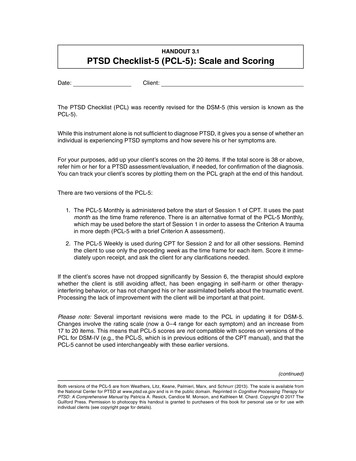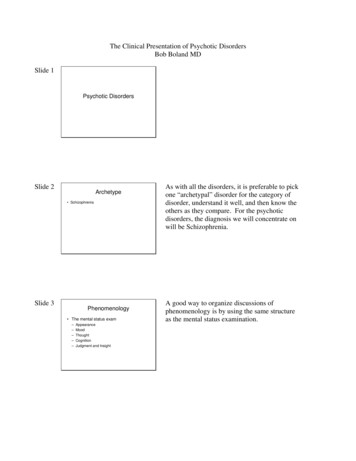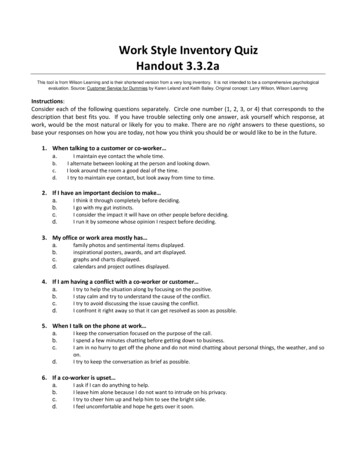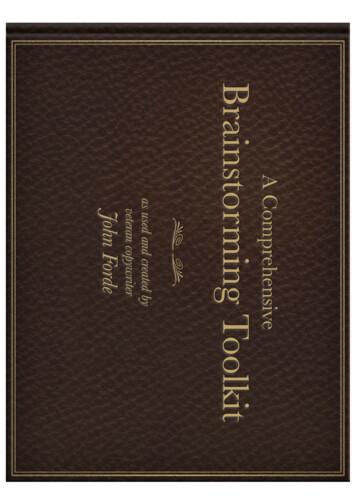
Transcription
THE HANDOUT BOOKComplete handoutsfrom the workshops ofBill O’Hanlon
Welcome to Handout LandThis compilation of my handouts has evolved over the course of a number of years. When I first began giving workshops andseminars, I would often read on the feedback forms, “Wish there would have been handouts since there was so much information.”So, I started making handouts. I guess I got a little carried away, though, as you can see with this book. Workshop sponsors startedsweating a bit when I sent 25 or 30 pages of handouts (I was restraining myself-I wanted to send 50). So, to save trees and tomake them available again after they have been out of print for some years, they are back, newly revised and compiled.Years ago, someone came up to me at a workshop and declared, “You give good handout!” I hope you agree. I have endeavored tochock these pages full of useful information and summaries.The work in this edition owes a great deal to my former assistant, Martha Geske, who died unexpectedly recently, and to mycurrent assistant, Bianca Sivan. Work on previous editions was done by Mary Nathan and Steffanie O’Hanlon. Thanks to them all.I produce a great deal of original work, but organizing it and making these compilations is not my forte. Without their good work,this would very likely not exist.Because I am committed to spreading these ideas, you have my permission to reproduce and of these handouts for colleagues,friends or clients. Please do not use them in any commercial (i.e., money-making) activities or products, though, and please keepmy name and contact information on them when you share them.Because this is an online version, we can make changes relatively easily. Please let us know about any corrections or suggestionsthat occur to you.Bill O’Hanlon, Santa Fe, NM, USAApril 2005Copyright 2005 O’Hanlon and O’Hanlon, Inc.223 N. Guadalupe #278, Santa Fe, NM 87501, USATel.: 505.983.2843Fax: 505.983.2761Email: PossiBill@brieftherapy.comWebsite: www.brieftherapy.comAll rights reserved
TABLE OF CONTENTSBrief, Solution and Possibility TherapyACCEPT FrameworkAcknowledgment and Possibility in InterviewingAcknowledgment, Valuing and ValidationAssessment QuestionsAssessment Questions – InpatientBasic Orienting Questions of Consumer-Oriented TherapyBrief Solution-Oriented Therapy BibliographyBrief Solution-Oriented Therapy SummaryBrief Therapy Assumptions and AssessmentBrief Therapy Research/DataBrief Therapy SupervisionChanging PatternsCollaborative Task Assignments: Basic PrinciplesCollaborative TherapyContrasting Traditional Therapy to Solution-Oriented ApproachesDeep ListeningDesigning Pattern and Framing InterventionsDiscouraging vs. Possibility Therapy Explanatory StylesElements of a Collaborative ConversationElements of ContextsEssentials of Possibility TherapyEvoking Client Solutions and CompetenceFinding A Focus in TherapyInterviewing for PossibilitiesInvestigating the Doing of ProblemsMap of Problem-LandMETA ModelNegotiating A Presentable ProblemNew Possibilities for Therapeutic ConversationsOverviews of Brief Solution-Oriented TherapyPossibility Therapy BibliographyPossibility Therapy: Key Concepts and MethodsPossibility Therapy SummaryPrinciples of the Collaborative Language System Therapy ApproachProblem/Solution MapProblematic StoriesSetting Achievable Goals in TherapySolution TalkSolution-Building StepsSolution-Oriented InterviewingSolution-Oriented Therapy: Key Concepts and MethodsSymbols and Healing RitualsTherapeutic Symbols/RitualsTypes of Questions and Statements in Solution-Based TherapyUnexamined Assumptions in PsychotherapyUse of Time in Possibility TherapyVarieties of Task AssignmentsEricksonian Therapy & Solution-Oriented HypnosisClass of Problems/Class of Solutions Model
Developing and Delivering Therapeutic MetaphorsDoing Solution-Oriented HypnotherapyElements of Solution-Oriented InductionErickson’s Therapeutic PatternEscaping Negative Symptom TrancesEvoking AmnesiaEvoking Hand/Arm LevitationGeneric Patterns In Erickson’s WorkThe Hitchhiker’s Guide To Solution-Oriented HypnosisMetaphor ClustersModels of MetaphorPhases of Erickson’s TherapyThe Process of Solution-Oriented Inner WorkSequence of Hypnotic InductionStrategies for Pain ControlSymptomatic Trance--------- Healing TranceTrance PhenomenaTranceports: The Four Doorways into Altered StatesUsing Presupposition in HypnosisWordsmithing in Solution-Oriented Inner WorkNarrative TherapyExternalizing ProblemsMetaphorical Frames in Narrative TherapyNarrative Therapy BibliographyResurrecting Or Discovering Alternate Identity Stories and Points of ViewTypes of Questions in Narrative TherapyTypes of Questions in White’s Narrative TherapyCouples, Families & RelationshipsAccountability and Change in Violent BehaviorAcknowledgmentAction ComplaintsAction PraiseAction RequestsActions, Stories, and ExperienceConjoint StrategiesContrasting Approaches to the Treatment of Domestic ViolenceEscalating Interventions for Destructive/Harmful Behavior in RelationshipsFive Levels of Intervention in Couples’ TherapyGuidelines for Couples’ CommunicationIntegrity, Boundaries/Limits, Consequences and AmendsIntimacyLoveLove is a Verb Summary PointsMaking Relationships LastMix’N’Match Sexual MenuNegotiated AgreementsRewriting Love Stories: Brief Couples’ TherapySexualitySolution-Oriented Couple and Family TherapySolution-Oriented Relationship CounselingStep-parenting Hints
Sexual AbuseAdults Molested As Children Five Session Group OutlineBeware of Overdiagnosing Multiple Personality DisorderBreaking the Bad Trance: Working with Couples in which one of the Partners has bee TraumatizedContrasting Approaches to the Treatment of the Aftereffects of Sexual AbuseDeveloping a Relationship with Devalued/Disowned/Dissociated Aspects of SelfFactual Questions about Sexual AbuseFundamentalism in Sexual Abuse TreatmentGuidelines for Avoiding False memories of Sexual AbuseInhibition and Intrusion: Polarities of Troublesome Aftereffects of TraumaInternalizing and Externalizing Moves in Possibility TherapyMoving On: Healing from Sexual AbusePossibility Therapy with Survivors of Sexual AbuseRecognizing and Standing for Your BoundariesSolution-Oriented Therapy with Sexual PerpetratorsSolution0Oreiented Treatment of Adults Abused As Children BibliographySolution-Oriented Treatment of Sexual Abuse AftereffectsSteps to Healing from Childhood Sexual AbuseThings that Can Make a Positive Difference for Children Who Have Been Sexually AbusedTreatment of Self-MutilationUsing the Inclusive Self in Treating Dissociated, Disowned and Devalued Aspects of SelfWorksheet for Developing a Relationship with Devalued/Disowned/Dissociated Aspects of SelfDrug and Alcohol MisuseAlternative Treatment of Alcohol and Drug MisuseContrasting Approaches to Treatment of Drug and Alcohol MisuseOverlaps of AA/Narrative ApproachesOverlaps of AA/Solution-Oriented ApproachesSpiritualityAssumptions of a Spiritual Approach to TherapyConnection, Compassion and ContributionDeveloping Self CompassionElements of Religion That Can be Incorporated into SpiritualityExamining Religious Premises and TraumaFour Soul SignalsSolution Oriented SpiritualitySpirituality and Therapy AssessmentThe Three Cs of SpiritualityThe Two Functions of the SoulHandouts for Clients or the General PublicChange 101Changing Persistent PatternsConversations About UpsetsDon’t Believe Everything You ThinkHow Not to Change: 10 Strategies for Staying StuckReclaiming Your EnergyReclaiming Your Life From FearWriting RitualHandouts That Don’t Fit Anywhere ElseClasses of SolutionSix Step Recovery Program for Adult Children of Dysfunctional TheoriesSkeptical Look at Biological PsychiatryWorking with Chronic and Severely “Mentally Ill” People and Their Families
FormsAction Plans/IdeasAudio/Videotaping Release FormClient QuestionnaireClosing NoteFollow-Up FormInitial InterviewSession Notes
Brief, Solution &Possibility Therapy
Bill O’Hanlon, M.S., Possibilities, 223 N. Guadalupe #278, Santa Fe, NM 87501800.381.2374; Fax# 505.983.2761; PossiBill@brieftherapy.com; http://www.brieftherapy.comTHE ACCEPT FRAMEWORKAcknowledging, Validating, and Valuing It is important to attend carefully to clients, acknowledging their points of views and feelings. It isalso important to communicate a basic liking for and valuing of the person. One can also give a sensethat the points of view and feelings of the person are valid or within the realm of normal humanexperience.Clarifying Concerns, Complaints and Goals or Directions Collaboratively explore clients’ concerns and complaints, that is, what they believe is troublingenough to have sought your help. The idea to seek help may be someone else’s and it is just asimportant to explore this. Then find out what the clients’ (and/or the people who think the client needshelp) view of what would constitute a successful outcome. Get such goals, outcomes and destinations inaction terms (so that one could see and hear what would be happening at that time). If the client doesn’twant goals that are so specific, one can always inquire about directions that would be preferred ratherthan specific outcomes.Changing the Viewing, the Doing and the Context Help people challenge patterns of their meaning-making (stories), what they are attending to,patterns of action and interaction, and any aspects of the context around the problem (cultural, gender,family background, neurological/physiological, spiritual aspects of clients’ lives).Evaluating Progress, Results and Outcomes Check in with people throughout the process to find out whether what you are working on with themis relevant and helpful. Use scaling and percentage questions, as well as feeling questions to assesshow things are going according to clients.Planning Next Steps Plan assignments for out of session experiments. Ask about when the next meeting should beaccording to them. Ask people whether they want to come back, whether they have made enoughprogress in the direction they wanted to stop the process of counseling or therapy or to take a break.Plan follow-up contacts and relapse prevention or recovery.Terminating Treatment Stop treatment by mutual agreement, leaving the possibility open for return for any future problemsor recurrence of previous problems.
Bill O’Hanlon, M.S., Possibilities, 223 N. Guadalupe #278, Santa Fe, NM 87501800.381.2374; Fax# 505.983.2761; PossiBill@brieftherapy.com; http://www.brieftherapy.comACKNOWLEDGMENT AND POSSIBILITY IN INTERVIEWINGIt is important to both acknowledge and validate clients without closing down the possibilities for change forthem. Too much emphasis on change and possibility can give clients the message that the therapist does notunderstand or care about their suffering or dilemmas. Too much emphasis on the acknowledgment side can givethe message that the client cannot change or might encourage wallowing in the pain and hopelessness. Thefollowing methods are designed to combine both acknowledgment and invitations to change and possibility.Remember that these are methods and if they start to become formulaic, they can be used disrespectfully orsuperficially. They are designed, however, to be respectful and to deeply empathize with clients’ suffering andpossibilities.Carl Rogers With a Twist: Introducing possibilities into past and present problem reports1. Reflect back clients’ problem reports into the past tense.Client: I’m depressed.Therapist: So you’ve been depressed.2. When clients give generalities about their problems, introduce the possibility that the problem is not so general. Reflectclients’ problem reports with qualifiers, usually of time (e.g., recently, in the last little while, in the past month or so, mostof the time, much of the time), intensity (e.g., a bit less, somewhat more) or partiality (e.g., a lot, some, most, many)Client: I’ve been really depressed.Therapist: You’ve been depressed most of the time lately.3. Translate clients’ statements of the truth into statements of clients’ perceptions or subjective realities.Client: From the things she has said and done, it is obvious she doesn’t care for me or our marriage.Therapist: Some of the things she’s done have given you the sense she doesn’t care.The Moving Walkway: Introducing a future with possibilities1. Recast a problem statement into a statement about the preferred future or goal.Client: I think I'm just too shy to find a relationship. I'm afraid of women and being rejected.Therapist: So you'd like to be able to get into a relationship?2. Use present or future tenses to reflect reports of past helpful attention, action and viewpoints.Client: I stopped myself from bingeing by calling a friend.Therapist: So one of the things you do to stop bingeing is call friends.3. Presuppose positive changes and progress toward goals by using words like “yet, “so far,” “when,” and “will.”Client: I broke up with my girlfriend and can’t seem to find another relationship.Therapist: So you haven’t gotten into a relationship yet. When you get into a relationship, we’ll know we’ve donesomething useful here.9
Bill O’Hanlon, M.S., Possibilities, 223 N. Guadalupe #278, Santa Fe, NM 87501800.381.2374; Fax# 505.983.2761; PossiBill@brieftherapy.com; http://www.brieftherapy.comACKNOWLEDGMENT, VALUING AND VALIDATION Acknowledging–Letting people know that you have noted their experience, points of view and actions. Validating/valuing–Letting people know that their experiences and points of view are valid and valued.Letting them know that some of their actions are valued (e.g., ethical actions that lead toward theirgoals) and some are not (e.g., physical violence). Giving permission–Letting people know that they can feel, experience, think or do things and that theydon’t have to feel, experience, think or do things. Normalizing is a form of permission. Including–Incorporating whatever concerns, experiences, objections and barriers people show/expressinto the conversation without it becoming a block to moving on towards solution. Inviting the person toinclude even devalued and unwanted aspects of themselves into their experience and definition ofthemselves. Both/and thinking. Participating with patterns-Matching verbal and nonverbal patterns with people. Calling to accountability–Holding people accountable for their actions without blaming them.10
Bill O’Hanlon, M.S., Possibilities, 223 N. Guadalupe #278, Santa Fe, NM 87501800.381.2374; Fax# 505.983.2761; PossiBill@brieftherapy.com; http://www.brieftherapy.comASSESSMENT QUESTIONSFor the client*How will we know when it’s time for you to leave therapy, when we’ve been successful? [Ask for a video description orget a scaling estimate.]*What happened that gave you or whoever thought you should be here the idea that therapy would be the best place tosort out the difficulty (difficulties)?*After you finish coming here, what kind of changes do you think you’ll make in your life?*What’s the first sign you’ll be able to notice that therapy had been helpful to you?*What’s the first sign others will be able to see when you start to (feel better; get better; feel more hopeful; really knowyou want to live; etc.)?*If you’ve experienced a similar difficulty before, how’d you deal with it?*How about one of the times when the difficulty started to develop, but you stopped it before it went too far? [If theydon’t report any positive coping experience, reply, “So you can't remember any time like that right now.”]*What was the high point of the last year for you?*Can you remember a time recently when you pleasantly surprised yourself or did something out of character that pleasedyou?*What medications or therapy approaches have worked best for you, if any?*What hobbies or interests do you have or have you had in the past? What was interesting or valuable about thoseactivities?*What kind of work do you do or have you done?*(For adolescent) What was/is your favorite subject or class in school? Why?*(For reports of previously overcome problems) You told me you used to use drugs or alcohol and then stopped. How didyou do that? or You told me you were suicidal last fall. How did you get through that time without harming yourself ordoing yourself in?For the referral source/family member*What gives you the idea that the person needs to be in treatment?*Who has been most upset or vocal about the client’s behavior?*How will you know that treatment has been successful and that I have done a good job? [Get a video description.]*What has been the most pleasantly surprising thing you’ve seen or heard from or about the client recently?*What would you like me to do to keep you informed on the client’s progress or to keep getting your input?11
Bill O’Hanlon, M.S., Possibilities, 223 N. Guadalupe #278, Santa Fe, NM 87501800.381.2374; Fax# 505.983.2761; PossiBill@brieftherapy.com; http://www.brieftherapy.comASSESSMENT QUESTIONS-INPATIENTFOR THE PATIENT How will we know when it's time for you to leave the hospital, when we've been successful? [Ask for avideo description.] Who decided it was a good idea for you to enter the hospital? What happened that gave them/you the idea that the hospital would be the best place to sort out thedifficulty (difficulties)? After you get out of the hospital, what kind of changes do you think you'll make in your life? What's the first sign you'll be able to notice that we'd been helpful to you while you're here? What's the first sign others will be able to see when you start to (feel better; get better; feel more hopeful;really know you want to live; etc.)? If you've experienced a similar difficulty before, how'd you deal with it? How about one of the times when the difficulty started to develop, but you stopped it before it went too far?[If they don't report any positive coping experience, reply, "So you can't remember any time like that rightnow."] What was the high point of the last year for you? Can you remember a time recently when you pleasantly surprised yourself or did something out of characterthat pleased you? What medications or therapy approaches have worked best for you, if any? What hobbies or interests do you have or have you had in the past? What was interesting or valuable aboutthose activities? What kind of work do you do or have you done? (For adolescent) What was/is your favorite subject or class in school? Why? (For reports of previously overcome problems) You told me you used to use drugs or alcohol and thenstopped. How did you do that? or You told me you were suicidal last fall. How did you get through thattime without harming yourself or doing yourself in?continues next page12
Bill O’Hanlon, M.S., Possibilities, 223 N. Guadalupe #278, Santa Fe, NM 87501800.381.2374; Fax# 505.983.2761; PossiBill@brieftherapy.com; http://www.brieftherapy.comFOR FAMILY MEMBERS What did (the patient) do that gave you (or whoever initiated hospitalization) the idea that he/she needed tobe in the hospital? Has (the patient) ever experienced a similar problem or shown similar behavior in the past? If so, how didyou or they get through that time? What helped the most? How did that episode stop? How will you know that we have done our job here at the hospital after (the patient) gets out? [Get a videodescription.] Tell me about a time when you or anyone in your family was pleasantly surprised by something (the patient)did.FOR THE REFERRAL SOURCE What gives you the idea that the person needs to be in the hospital? Who has been most upset or vocal about the patient's behavior? How will you know that the hospitalization has been successful and that we have done a good job? [Get avideo description.] Do you have any concerns based on your past experience with hospitalizing someone here that we should beaware of? What would you like us to do to keep you informed on the patient's progress or to keep getting your input?13
Bill O’Hanlon, M.S., Possibilities, 223 N. Guadalupe #278, Santa Fe, NM 87501800.381.2374; Fax# 505.983.2761; PossiBill@brieftherapy.com; http://www.brieftherapy.comTHE BASIC ORIENTING QUESTIONSOF CONSUMER-ORIENTED THERAPY1. What brings you here or concerns you (or the person who suggested you come see me)?This is sometimes called “determining the customer.” It also clarifies the complaint that drove someone toseek or recommend therapy. If the therapist does not find this out and keep it in mind during the treatment,it usually indicates that the therapist believes that his or her theories about the person’s or family’s issues ismore important than the clients’.2. What do you (or they) want as a result? What will show you and others that this result has beenachieved?This helps define a stopping point for successful therapy according to clients’ definitions, rather thantherapists’ values and agendas. The question about showing self and others is important because it is hardto know when it is time to stop if it isn’t defined in a clearly observable way.3. What has worked in regard to your concern and what hasn’t? This could include past help you havereceived or past attempts by you or others to resolve your concerns.This information helps avoid mistakes from the past and helps to focus on what things have helped and whatis important to change.4. Is what we are talking about relevant and helpful? Is what we are doing working?This information helps keep the therapy on track and can allow for mid-course corrections during theinterview and between meetings.14
Bill O’Hanlon, M.S., Possibilities, 223 N. Guadalupe #278, Santa Fe, NM 87501800.381.2374; Fax# 505.983.2761; PossiBill@brieftherapy.com; http://www.brieftherapy.comBRIEF SOLUTION-ORIENTED THERAPY BIBLIOGRAPHYBerg, Insoo & Miller, Scott (1992) Working With the Problem Drinker: A Solution-Focused Approach.New York: Norton.Berg, Insoo Kim (1994) Family-Based Services: A Solution-Focused Approach. New York: Norton.Bertolino, Bob and O’Hanlon, Bill. (2001) Collaborative, Competency-Based Counseling and Therapy.Needham, MA: Allyn & Bacon.Cade, Brian & O’Hanlon, William H. (1993) A Brief Guide to Brief Therapy. New York: Norton.Chevalier, A.J. (1995) On the Client’s Path: A Manual for the Practice of Brief Solution-FocusedTherapy. Oakland, CA: New Harbinger.Chevalier, A.J. (1996) On the Counselor’s Path: A Guide to Teaching Brief Solution-Focused Therapy.Oakland, CA: New Harbinger.De Shazer, Steve (1985) Keys to Solution in Brief Therapy. New York: Norton.De Shazer, Steve (1988) Clues: Investigating Solutions in Brief Therapy. New York: Norton.Dolan, Yvonne (1991) Resolving Sexual Abuse. New York: Norton.Durrant, Michael (1993) Residential Treatment: A Cooperative, Competency-Based Approach toTherapy & Program Design. NY: Norton.Durrant, Michael (1993) Creative Strategies for School Problems. Epping, NSW, Australia: EastwoodFamily Therapy Centre.Friedman, Steven & Fanger, M. T. (1991) Expanding Therapeutic Possibilities: Getting Results in BriefTherapy. Lexington, MA: DC Heath.Furman, Ben and Ahola, Tapani (1992) Solution Talk: Hosting Therapeutic Conversations. New York:Norton.Hudson, Patricia O. & O’Hanlon, William H. (1992) Rewriting Love Stories: Brief Marital Therapy. NewYork: NortonLethem, Jane (1995) Moved to Tears, Moved to Action: Solution-focused brief therapy with women andchildren. London: BT Press [17 Avenue Mansions, Finchley Rd., London NW3 7AX, UK].Miller, Scott & Berg, Insoo (1995) The Miracle Method: A Radically New Approach to ProblemDrinking. New York: Norton.15
Bill O’Hanlon, M.S., Possibilities, 223 N. Guadalupe #278, Santa Fe, NM 87501800.381.2374; Fax# 505.983.2761; PossiBill@brieftherapy.com; http://www.brieftherapy.comMurphy, John J. (1997) Solution-Focused Counseling in Middle and High Schools. Alexandria: AmericanCounseling Association [5999 Stevenson Ave., Alexandria, VA 22304].O’Hanlon, Bill and Wilk, James (1987) Shifting Contexts: The Generation of Effective Psychotherapy.New York: Guilford.O’Hanlon, William H. (1987) Taproots: Underlying Principles of Milton Erickson’s Therapy andHypnosis. New York: Norton.O’Hanlon, William H. and Weiner-Davis, Michele (1988) In Search of Solutions: A New Direction inPsychotherapy. New York: Norton.O’Hanlon, Bill and Beadle, Sandy (1994) A Field Guide to PossibilityLand: Possibility Therapy Methods.Omaha: Possibility Press.Quick, Ellen (1996) Doing What Works in Brief Therapy. San Diego: Applied Psychology.Selekman, Matthew (1993) Pathways to Change: Brief Therapy Solutions with Difficult Adolescents.New York: Guilford.Walter, John and Peller, Jane (1992) Becoming Solution Focused in Brief Therapy. New York:Brunner/Mazel.Webb, Willyn (1999) Solutioning: Solution-Focused Interventions for Counselors. Philadelphia:Accelerated Development, a member of Taylor& Francis Group.16
Bill O’Hanlon, M.S., Possibilities, 223 N. Guadalupe #278, Santa Fe, NM 87501800.381.2374; Fax# 505.983.2761; PossiBill@brieftherapy.com; http://www.brieftherapy.comBRIEF SOLUTION-ORIENTED THERAPY SUMMARY Validate and acknowledge each person’s feelings and points of view without closing down thepossibilities for changeReflect back feelings and points of view about the problem in the past tense (“were,” “have been”)Reflect back points of view as if they are points of view and not the truth (“seen,” “looked to you,” “had theimpression,” “got the sense”)Create little openings in generalizations (“most of the time,” “usually,” “a lot”) Search for exceptions to the problemGently steer the focus to what has happened when the problem hasn’tDon’t try to convince them of exceptions, let them convince youHighlight any exceptions you hear Translate labels and vague words into action descriptionsFind video descriptions for labels (“What does codependent look like?”)Get specific about vague words and phrases (“Something’s bothering you? What specifically?”“Everything?”)Find action correlates for feelings (“Tell me what kinds of things you do when you are depressed.”) Focus on achievable goals and outcomesObtain a video description of actions that are under the person’s control that will be happening when theproblem is solved. Search for evidence of change and internal or external resourcesWhen the person relates some positive change from the distant or recent past, find out in detail how they gotthe change to happen or influenced itWho or what has been helpful when they have been stuck or having difficulties previously Suggest new ways of thinking about things or doing thingsSuggest different interpretations and actions involving the problem Make an action plan for between meetingsWrite down a specific task that has been negotiated during the session and follow up on the task at the nextsessionMake sure it is realistic and the person has agreed to it17
Bill O’Hanlon, M.S., Possibilities, 223 N. Guadalupe #278, Santa Fe, NM 87501800.381.2374; Fax# 505.983.2761; PossiBill@brieftherapy.com; http://www.brieftherapy.comBRIEF THERAPY ASSUMPTIONS AND ASSESSMENTAssumptions Assessment and interviewing are interventions; clients and therapists co-create problem definitions andtherapy realities. What gets focused on in the therapy session and conversation increases in clients’ and therapists’ awarenessand in its prevalence. Clients have resources and strengths to solve problems. People are changeable in some areas of their lives; rapid resolution of complaints is possible. It is not always necessary to know the true cause, history or function of a problem in order to resolve it. People are accountable for their actions and can change actions at any moment regardless of background,mental status or emotional state. Clients are resistant and/or uncooperative when we haven’t listened to them, have blamed or invalidated themor are not being helpful to them.Assessment Considerations Assessment is always an ongoing process, changing as you learn more about the client. You don’t have toget “the right diagnosis” before making interventions. Who is complaining or alarmed? Who thinks there is a problem? What is the person complaining about?This becomes the focus of treatment. What are the goals? How will we know when we are done?Get specific about the problem-free future.What’s the smallest noticeable change? [Hint: It may have already happened.] What is the person motivated for? What does he or she want? What does the person do well? (Find contexts of competence.)Skills, hobbies, sports, activities, avocations, life experiences, etc.Exceptions/previous solutions/times when situation was betterBest coping momentsPast-Problem-related; non problem-relatedPresent-During interviewFuture-Miracle question; video question What are the patterns of the problem? How is it performed?Search for regularities of action and interaction, time, place, body behavior, etc.could imagine seeing/hearing the problem on a videotape)Get specific (so one Scan for potentially harmful actions of clients or others in clients’ lives (e.g., physical violence, drug/alcoholabuse, sexual abuse, self-mutilation, suicidal intentions/attempts, etc.) that may not be obvious or may beminimized during an initial interview. Acknowledge and validate each client and his/her points of view without closing down the possibilities forchange.18
Bill O’Hanlon, M.S., Possibilities, 223 N. Guadalupe #278, Santa Fe, NM 87501800.381.2374; Fax# 505.983.2761; PossiBill@brieftherapy.com; http://www.brieftherapy.comBRIEF THERAPY RESEARCH/DATA In well-designed psychotherapy studies, distinguished by experienced therapists, clinically representative clients andappropriate controls and follow-up, brief therapy has been shown to be as effective as longer courses of treatment.[Koss and Butcher (1986) “Research on brief psychotherapy,” (pp. 627-670) in Garfield and Bergin (Eds.)Handbook of Psychotherapy and Behavior Change. NY: Wiley.] Average duration of therapy is 5-8 sessions in both private practice and community mental health cente
Contrasting Approaches to the Treatment of Domestic Violence Escalating Interventions for Destructive/Harmful Behavior in Relationships Five Levels of Intervention in Couples’ Therapy Guidelines for Couples’ Communication Integrity, Boundaries/Limits, Consequences and Amends Intimacy Lov











